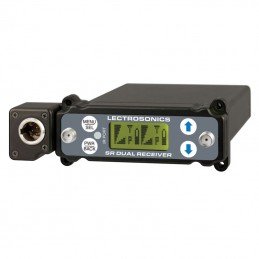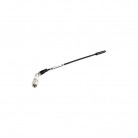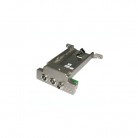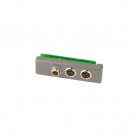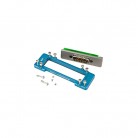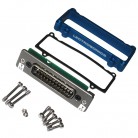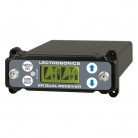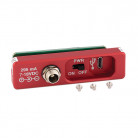- Bags & Harnesses
- Blowout Items
- Boom Poles
- Cables & Adapters
- Carts
- Cases
- Communications
- Computer Audio
- Deals
- Expendables
- Grip
- Headphones, Headsets & Earsets
- Interfaces
- Microphone Accessories
- Microphones
- Miscellaneous
- Mixers & Preamps
- Parts
- Power
- Recorders & Players
- Speakers
- Time Code & Sync
- Video
- What's New
- Wireless
- Used Audio Equipment
Lectrosonics SRc5P Dual-Channel Slot Mount ENG Receiver
The Lectrosonics SRc and SRc5P design includes two separate receivers built into a single, ultra compact housing with adapters for video camera receiver slots and for stand-alone use. Digital Hybrid Wireless technology provides superb, compandor-free audio quality and compatibility with other wireless systems. The RF performance is extremely stable over a very wide temperature range, making the receiver perfectly suited to the rough environmental conditions found in field production.
DSP compatibility modes allow the receiver to be used with a variety of Lectrosonics systems, other brands of wireless systems and with Lectrosonics IFB transmitters.
The front panel features a menu-driven LCD interface and four membrane switches which are used to view and alter settings. The main LCD window displays the pilot tone indicator, diversity activity, RF level, audio level and transmitter battery status for both receivers. To find clear operating frequencies, a built-in spectrum analyzer scans across the tuning range of the receiver and displays a histogram of RF activity across the band. Areas with little or no RF activity are easily recognizable.
The two internal receivers can be operated separately, each using switching, antenna combining diversity, or in tandem with ratio diversity reception. The audio outputs of the receivers can be mixed internally, or left separated for discrete recording tracks or external mixing. A variety of output adapters and mounting options are available for camera slot operation. The receivers are powered from an external 7 to 18 volt DC source. The SRc5P model provides a 5-pin connector next to the control panel with audio output from both channels in addition to the camera slot outputs.
Lectrosonics SRc / SRc5P - Features:
- Fits camera "slots", Lectrosonics Duopack adapter, Octopack multicoupler, and operates stand-alone with various adapters
- Tunes over a 76 MHz range (3 blocks)
- Dual receiver design for two channels with phase switched diversity or single channel with ratio diversity operation
- Digital Hybrid Wireless with compatibility modes for use with earlier transmitters
- Tracking front-end filters for high performance in tough RF environments
- LCD with RF spectrum scanning
- SmartSquelch™ DSP-controlled, noise based filtering and squelch
- DSP-based pilot tone for squelch control
- IR sync port for quick transmitter setup
- SmartTune™ operation for quick and confident frequency selection
Three Block Tuning Range
The SRc and SRc5P receivers tune across a range of over 76 MHz. This tuning range covers three standard Lectrosonics frequency blocks.
Four tuning ranges are available covering standard blocks as follows:
| Band | Blocks Covered | Frequency |
|---|---|---|
| A1 | 470, 19, 20 | 470.1 - 537.5 MHz |
| B1 | 21, 22, 23 | 537.6 - 614.3 MHz |
To simplify backward compatibility with earlier Digital Hybrid Wireless equipment, block numbers are presented along with frequencies in LCD screens.
RF Front-End With Tracking Filter
A wide tuning range is helpful in finding clear frequencies for operation, however, it also allows a greater range of interfering frequencies to enter the receiver. The UHF frequency band, where almost all wireless microphone systems operate, is heavily populated by high power TV transmissions. The TV signals are immensely more powerful than a wireless microphone transmitter signal and will enter the receiver even when they are on significantly different frequencies than the wireless system. This powerful energy appears as noise to the receiver and has the same effect as the noise that occurs with extreme operating range of the wireless system (noise bursts and dropouts). To alleviate this interference, front-end filters are needed in the receiver to suppress RF energy below and above the operating frequency.
Each receiver employs a variable frequency, tracking filter in the front-end section (the first circuit stage following the antenna). As the operating frequency is changed, the filters re-tune to stay centered over the selected carrier frequency.
In the front-end circuitry, a tuned tracking filter is followed by an amplifier and then another tuned tracking filter to provide the selectivity needed to suppress interference, yet provide a wide tuning range and retain the sensitivity needed for extended operating range.
IF (Intermediate Frequency) Filters
Following the front-end, the incoming RF signal in each receiver is mixed down to a lower frequency for additional filtering with two SAW (Surface Acoustic Wave) filters. The use of two filters significantly increases the depth of filtering while preserving sharp skirts, constant group delay, and wide bandwidth.
Digital Pulse Counting Detector
Following the IF section, the receiver uses an elegantly simple, yet highly effective digital pulse counting detector to demodulate the FM signal to generate the audio, rather than a conventional quadrature detector. This unusual design eliminates thermal drift, improves AM rejection, and provides very low audio distortion.
DSP-Based Pilot Tone
The Digital Hybrid system design uses a DSP generated ultrasonic pilot tone to reliably mute the audio when no RF carrier is present. The pilot tone must be present in conjunction with a usable RF signal before the audio output will be enabled. 256 pilot tone frequencies are used across each 25.6 MHz block within the tuning range of the system. This alleviates erroneous squelch activity in multichannel systems where a pilot tone signal can appear in the wrong receiver via IM (intermodulation).
Automatic Power State Restoration
The firmware "remembers" whether it was turned on or off when power is disconnected and returns to that state when power is restored.
SmartSquelch™
A DSP-based algorithm named SmartSquelch™ optimizes the receiver performance in very weak signal conditions. The RF level and supersonic noise in the audio are continuously monitored to determine the appropriate noise reduction needed and the point at which squelch (complete muting of the audio) is necessary.
SmartTune™ Frequency Selection
SmartTune™ simplifies setup by scanning the tuning range of the receiver or a selected frequency block, and automatically setting a channel to the best available frequency. A prompt appears, reminding the user to use IR sync or manual settings to tune the transmitter to the selected frequency, then turn it on so the receiver sees it. Then, a prompt asks if the process should continue for the second channel. This process allows very quick and accurate tuning, whatever the RF environment.
Front Panel Controls And Functions
The control panel is a rugged, dust and water resistant design with membrane switches for the control interface. A backlit, graphics-type LCD is used to set up and monitor the receiver. Navigation through the menus is straightforward with text prompts for value and mode selections. In the ratio diversity mode, the Main Window displays audio levels, transmitter battery status, pilot tone status and RF level activity for both receivers, with a single audio channel display.
The SRc5P version is intended for use with cameras that do not have both audio channels enabled in the camera slot. In addition to the audio outputs on the rear panel, a second set of outputs are also provided through a 5-pin connector on an adapter next to the control panel. The TA5M connector next to the control panel provides two balanced outputs with the following pinouts:
| Pin 1 | Pin 2 | Pin 3 | Pin 4 | Pin 5 |
|---|---|---|---|---|
| Shields | CH1 + | CH1 - | CH2 + | CH2 - |
Rear Panel And Slot Adapter Kits
Several different rear panel adapters (SREXT, SRSNY, SRSUPER) are available to configure the receiver for popular camera slots and for stand-alone use. The rear panels are held in place by two screws and are easily changed. Camera slot adapter kits include top panel bezels with hardware for a secure fit into the camera body.
Battery Adapter
The receiver can be powered with the optional battery "sled" adapter, SRBATTSLEDTOP, that accepts standard "L" and "M" style rechargeable batteries. The adapter includes an integrated SREXT plate for the rear panel audio outputs. Typical runtime with a 7.2 V, 2200 mA "L" style battery is approximately 11 hours.
CONSUMER ALERT: This particular wireless microphone device operates in portions of the 617-652 MHz or 663-698 MHz frequencies. Beginning in 2017, these frequencies are being transitioned by the Federal Communications Commission (FCC) to the 600 MHz service to meet increasing demand for wireless broadband services. Users of this device must cease operating on these frequencies no later than July 13, 2020. In addition, users of this device may be required to cease operations earlier than that date if their operations could cause harmful interference to a 600 MHz service licensee’s wireless operations on these frequencies. For more information, visit the FCC's wireless microphone website or call the FCC at 1-888-CALL-FCC (TTY: 1-888-TELL-FCC).


